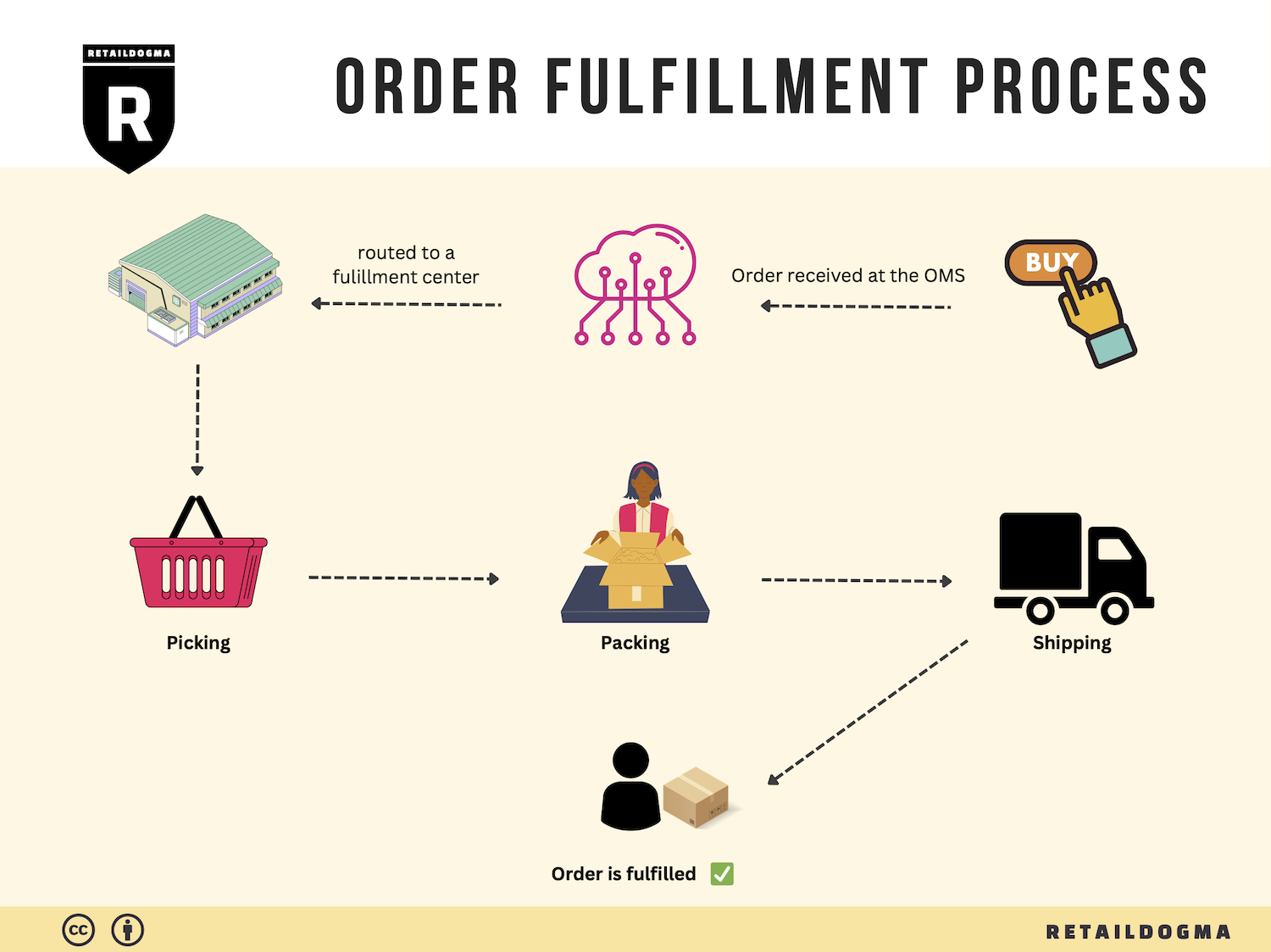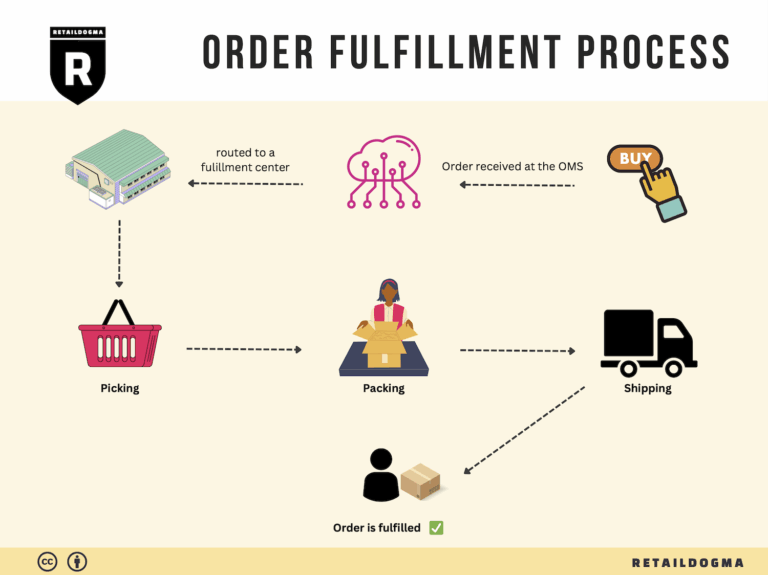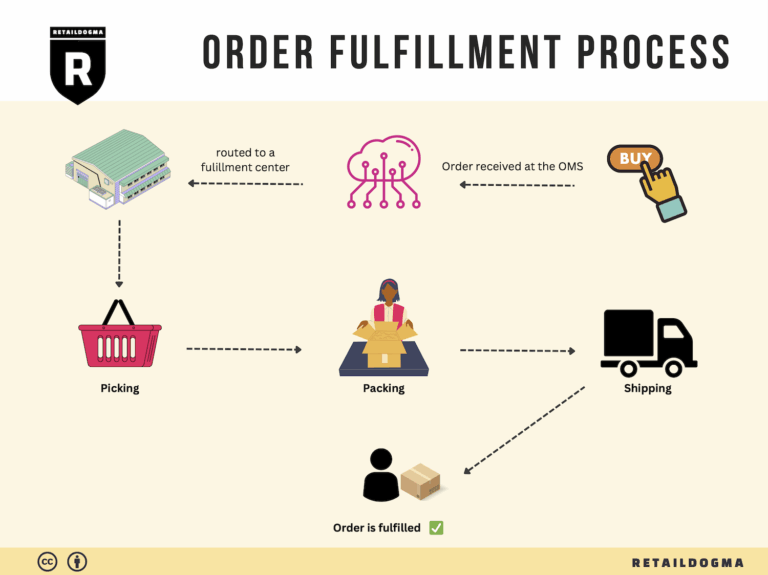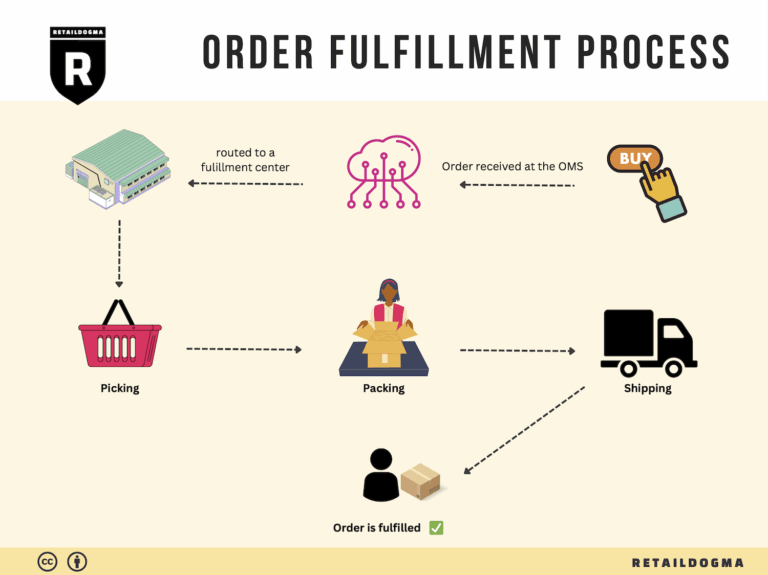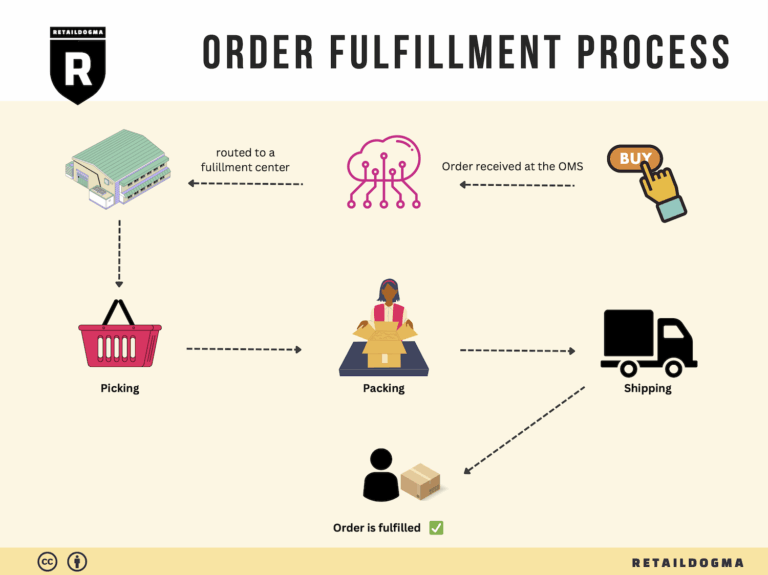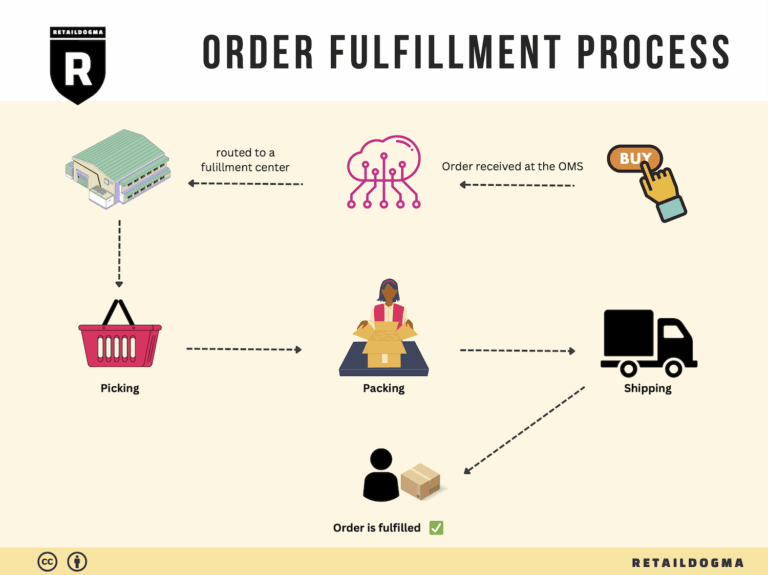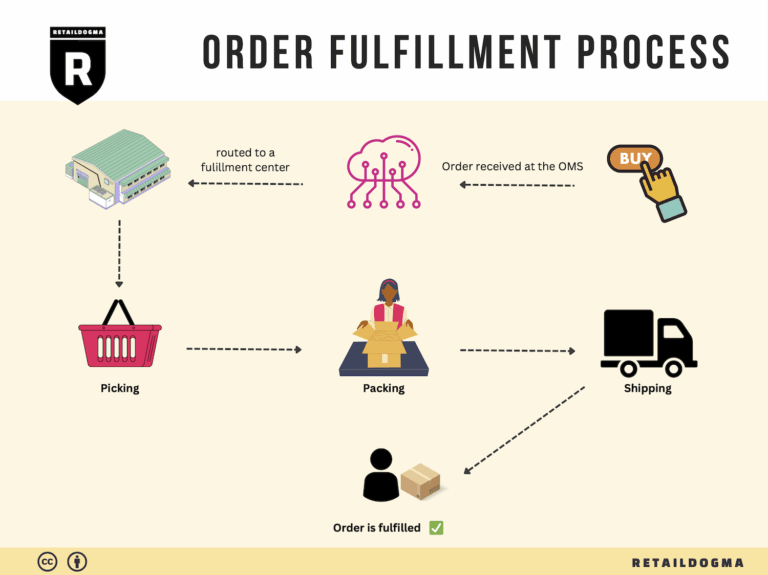How Order Fulfillment Works: A Step-by-Step Guide for Businesses
What is E-commerce Fulfillment? An Introduction for Growing Businesses
Understanding E-commerce Fulfillment
As your online business grows, one of the most common pain points you may encounter is the overwhelming task of packing and shipping orders. Managing logistics can quickly become a bottleneck, distracting you from focusing on your core business activities, such as marketing and product development. This is where understanding e-commerce fulfillment becomes essential.
At its core, fulfillment is the process of getting a product from your warehouse or inventory to your customer’s doorstep. It encompasses everything from order processing and inventory management to packaging and shipping. As your sales volume increases, the complexity of these tasks can escalate, making it critical to have a robust fulfillment strategy in place.
This guide aims to demystify e-commerce fulfillment for growing businesses by exploring various models and services available in the market. We will cover essential fulfillment models such as Third-Party Logistics (3PL), Fulfillment by Amazon (FBA), and more. Each model has its unique advantages and can significantly impact your operational efficiency and customer satisfaction.
We will also dive into the core services that fulfillment providers offer, which include but are not limited to order management, inventory storage, packing, shipping, and returns processing. Understanding these services will help you identify what you truly need from a fulfillment partner.
Choosing the right fulfillment partner is a critical decision that can affect your bottom line. We will discuss key factors to consider when selecting a provider, including their technology capabilities, service offerings, location, and pricing structures. With the right partner, you can streamline your operations and improve your customer experience, ensuring your business is well-equipped to scale.
Lastly, we will touch on pricing models for fulfillment services, helping you understand the cost implications of various options. By evaluating these factors, you can make informed decisions that align with your business goals and budget.
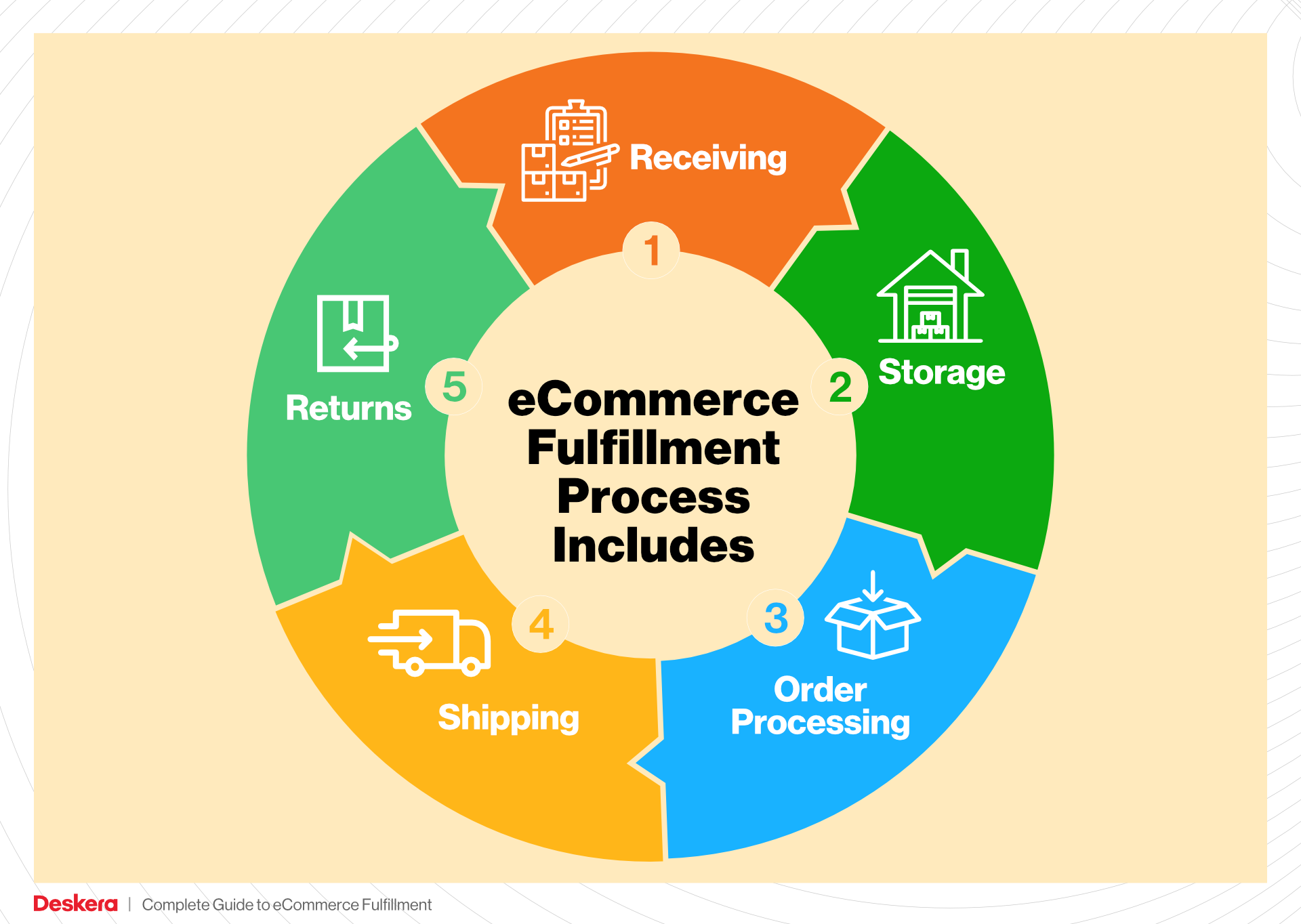
The ultimate goal of this guide is to empower you to make smart, strategic decisions about your logistics operations. By understanding e-commerce fulfillment, you can not only alleviate the pressures of packing and shipping but also position your business for sustainable growth in the competitive online marketplace.
What You’ll Learn In This Guide
- What is E-commerce Fulfillment? An Introduction for Growing Businesses
- The Order Fulfillment Process: From ‘Buy’ Button to Customer’s Door
- Comparing Fulfillment Models: In-House vs. 3PL vs. Dropshipping
- A Deep Dive into Amazon FBA: Pros, Cons, and Who It’s For
- Core Services Offered by Fulfillment Centers
- How to Choose a Fulfillment Partner: A 6-Point Checklist
- Understanding Fulfillment Pricing: A Breakdown of Common Fees
- Frequently Asked Questions (FAQs) about Fulfillment
- Conclusion: Is Outsourcing Fulfillment the Right Move for Your Business?
- Important Disclaimer
The Order Fulfillment Process: From ‘Buy’ Button to Customer’s Door
1. Receiving Inventory
The first step in the order fulfillment process is receiving inventory. Upon arrival at the warehouse, products are unloaded, and their quantities and conditions are verified against purchase orders. This step is crucial for maintaining accurate inventory levels and ensuring that the correct items are in stock.
Why It’s Important: Proper receiving practices prevent discrepancies that could lead to stockouts or overstock situations. By tracking items accurately, businesses can maintain operational efficiency and customer satisfaction.
Key Term: SKU (Stock Keeping Unit) – A unique identifier for each product, facilitating efficient tracking and management of inventory.
2. Warehouse Storage
After inventory is received, products are organized and stored within the warehouse. This involves placing items in designated locations based on a systematic storage plan. Efficient warehouse storage optimizes space and enhances accessibility, reducing the time needed to locate products when orders come in.
Why It’s Important: Effective storage strategies minimize the risk of damage and loss, while maximizing the use of available space. A well-organized warehouse also allows for faster order processing, which is essential for meeting customer expectations.

Key Term: ABC Analysis – A categorization method that ranks inventory items based on their importance, helping businesses prioritize storage and management efforts.
3. Order Picking
Once an order is placed, the next step is order picking, where items are retrieved from storage to fulfill customer requests. Warehouse staff use pick lists, which outline the items needed for each order, along with their locations within the warehouse.
Why It’s Important: Efficient picking is critical for maintaining quick turnaround times and ensuring that customers receive their orders accurately. Errors in picking can lead to returns, increased costs, and dissatisfaction.
Key Term: Pick Lists – Documents that guide warehouse staff in selecting the correct items for an order, crucial for accuracy and efficiency in the picking process.
4. Order Packing
After items have been picked, they move to the packing stage. Here, products are carefully packed into boxes or containers, often accompanied by packing slips that summarize the order details. This step may also involve quality checks to ensure that the right items are packed and in good condition.
Why It’s Important: Proper packing protects products during transit and enhances the customer experience. A well-packed order reduces the likelihood of damage and returns, contributing to customer satisfaction and loyalty.
Key Term: Packing Slip – A document included in the shipment that lists the items contained in the package, serving as a receipt for the customer and helping to confirm order accuracy.
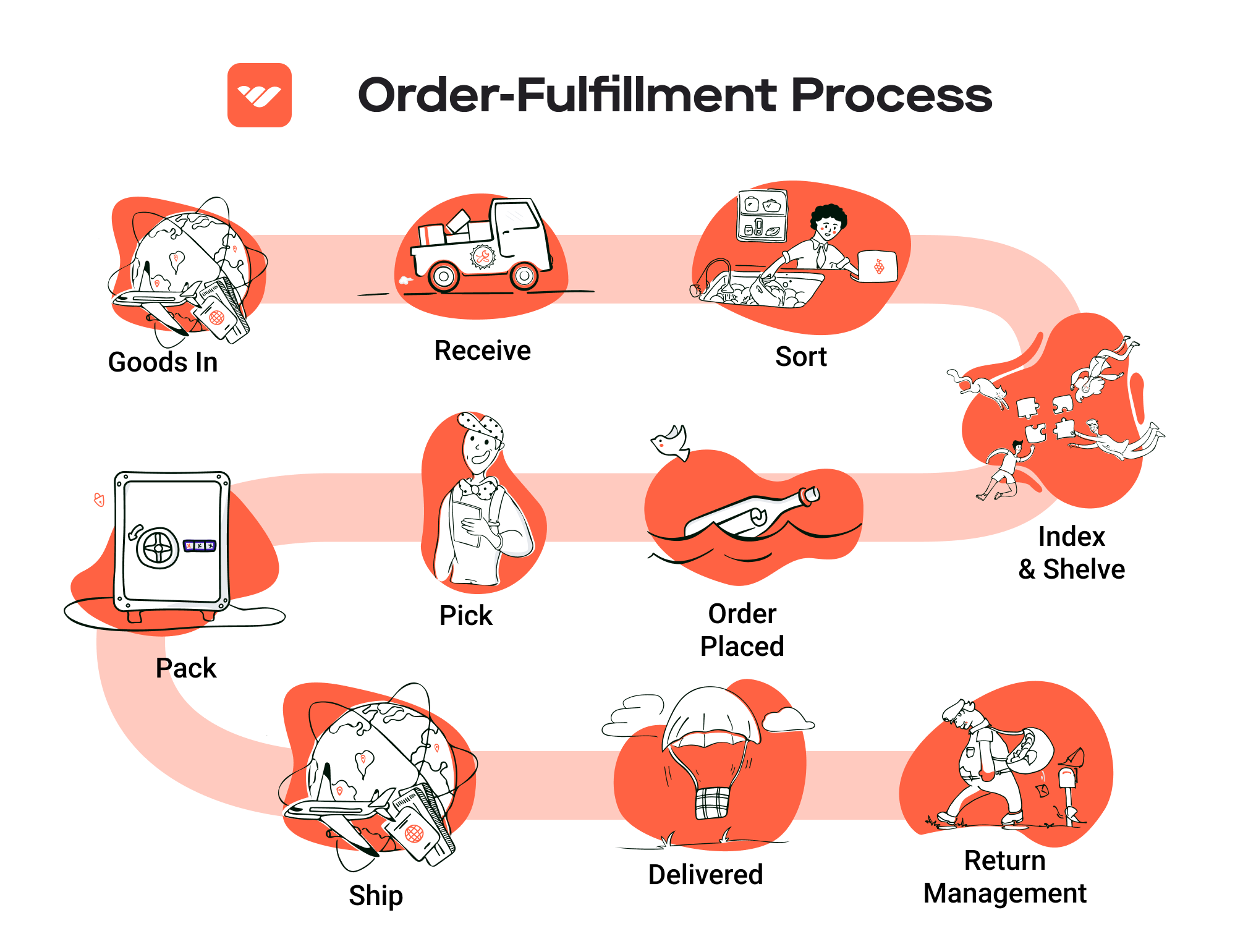
5. Shipping & Delivery
The final step in the order fulfillment process is shipping and delivery. Once packed, orders are labeled and scheduled for shipment via chosen carriers. This stage includes selecting the most efficient shipping methods and managing logistics to ensure timely delivery.
Why It’s Important: Timely shipping is crucial for customer satisfaction and can significantly impact a business’s reputation. Efficient logistics management helps optimize costs and improves overall service levels.
Key Term: Last Mile Delivery – The final step in the delivery process where the package reaches the customer’s door, often considered the most critical aspect of logistics due to its impact on customer satisfaction.
In conclusion, each step in the order fulfillment process is interconnected, and attention to detail at every stage is vital for operational success. By understanding and optimizing these steps, e-commerce businesses can enhance their efficiency, reduce costs, and improve the overall customer experience.
Comparing Fulfillment Models: In-House vs. 3PL vs. Dropshipping
Comparison of Fulfillment Models
| Model | Who Handles Inventory | Best For (Business Stage) | Key Advantage | Key Disadvantage |
|---|---|---|---|---|
| In-House Fulfillment | The business itself | Established businesses with stable demand | Complete control over inventory and processes | High operational costs and resource-intensive |
| Third-Party Logistics (3PL) | Third-party provider | Growing businesses needing flexibility | Scalable solutions and reduced overhead | Less control over inventory and processes |
| Dropshipping | Supplier | Startups and niche businesses | Low upfront investment and risk | Lower profit margins and reliance on suppliers |
In-House Fulfillment
In-house fulfillment refers to a model where the business manages its own inventory, warehousing, and shipping operations. This approach is typically adopted by established businesses that have a stable demand for their products. The key advantage of in-house fulfillment is the complete control it provides over inventory management, order processing, and shipping logistics. Businesses can tailor their operations to meet specific customer needs and maintain high levels of quality assurance. However, this model comes with significant disadvantages, including high operational costs and the need for substantial resources, such as warehousing space and staff. Additionally, as demand fluctuates, businesses may struggle with overstocking or stockouts, leading to potential losses.
Third-Party Logistics (3PL)
Third-party logistics (3PL) involves outsourcing fulfillment services to a specialized provider. This model is ideal for growing businesses that require flexibility and scalability in their operations. The primary advantage of 3PL is the ability to scale services up or down based on demand without the burden of maintaining physical inventory and logistical operations. This can significantly reduce overhead costs and allow businesses to focus on their core competencies, such as marketing and product development. However, the trade-off is that businesses relinquish some control over their inventory and fulfillment processes. This can lead to challenges in quality assurance and customer service, particularly if the 3PL provider does not align with the business’s standards or practices.
Dropshipping
Dropshipping is a fulfillment model where the retailer does not hold any inventory but instead partners with suppliers who ship products directly to customers on behalf of the retailer. This model is particularly suited for startups and niche businesses that are testing new products or markets, as it requires low upfront investment and minimizes the financial risk associated with inventory management. The primary advantage of dropshipping is the flexibility it offers; businesses can quickly adapt their product offerings without the financial burden of unsold inventory. However, dropshipping also comes with significant drawbacks, including lower profit margins and reliance on suppliers for product quality and delivery times. Any delays or issues from the supplier can directly impact customer satisfaction and the retailer’s reputation.
Conclusion
Each fulfillment model—In-House, 3PL, and Dropshipping—offers distinct advantages and challenges that can significantly impact an e-commerce business’s growth and operational efficiency. The choice of model should align with the business’s current stage, operational capabilities, and long-term goals. By understanding the nuances of each fulfillment strategy, business owners can make informed decisions that best support their objectives and enhance their overall supply chain effectiveness.
A Deep Dive into Amazon FBA: Pros, Cons, and Who It’s For
Understanding Fulfillment by Amazon (FBA)
Fulfillment by Amazon (FBA) is a service offered by Amazon that allows sellers to store their products in Amazon’s fulfillment centers. Amazon then takes care of storage, packaging, shipping, and customer service on behalf of the sellers. This service enables e-commerce businesses to leverage Amazon’s vast logistics network and customer base, making it an attractive option for many online retailers.
How FBA Works
-
Product Preparation: Sellers prepare their products according to Amazon’s guidelines, including labeling and packaging.
-
Shipping to Amazon: Once the products are ready, sellers ship them directly to Amazon’s fulfillment centers. Amazon provides specific instructions on where to send inventory based on geographical needs.
-
Storage: The products are stored in Amazon’s warehouses until they are sold. Amazon manages inventory levels and storage conditions.
-
Order Fulfillment: When a customer places an order, Amazon picks, packs, and ships the product on behalf of the seller. This process is expedited thanks to Amazon’s advanced logistics systems.
-
Customer Service: Amazon handles all customer inquiries and returns related to FBA products, which simplifies the seller’s workload.
-
Payments: Sellers receive payments after the sale, minus Amazon’s fees for using the FBA service.
Pros of FBA
Prime Eligibility
One of the most significant advantages of using FBA is the ability for products to be eligible for Amazon Prime. This means that customers can receive their orders with fast, free shipping, which is a major draw for many online shoppers. Prime members often prefer products that are FBA-eligible, leading to increased visibility and potentially higher sales.
Customer Trust
Amazon is a trusted name in e-commerce, and utilizing FBA can transfer some of that trust to sellers. Customers are more likely to purchase from sellers who use FBA, as they benefit from Amazon’s reliable customer service and return policies. This can lead to higher conversion rates and repeat business.
Multi-Channel Fulfillment
FBA allows sellers to fulfill orders from other sales channels, such as eBay or their own websites, using Amazon’s fulfillment network. This means that sellers can streamline their logistics and inventory management, benefiting from Amazon’s infrastructure while maintaining a presence on multiple platforms.
Cons of FBA
High Fees
While FBA can simplify many aspects of order fulfillment, it comes with costs that can eat into profit margins. Sellers must pay for storage fees based on the amount of space their inventory occupies, as well as fulfillment fees for each item sold. These costs can accumulate quickly, particularly for slow-moving inventory.
Strict Inventory Rules
Amazon has strict policies regarding inventory management, including guidelines on product condition and labeling. Sellers must adhere to these rules closely, or they risk incurring additional fees or having their products removed from the platform. This can be a significant burden for businesses that may not have the resources to manage these complexities.
Commingling Risks
FBA products from different sellers can be stored together in Amazon’s fulfillment centers, a practice known as commingling. While this can streamline logistics, it also poses risks. If a customer returns a product, there is a chance that it may not be the seller’s original item, leading to potential issues with product quality and brand reputation.
Who is FBA Best For?
Fulfillment by Amazon is particularly well-suited for:
-
Small to Medium-Sized Businesses: Those who may not have the resources to manage their own logistics and warehousing will find FBA to be a cost-effective solution that allows them to focus on product development and marketing.
-
E-commerce Entrepreneurs: New sellers looking to enter the marketplace can benefit from Amazon’s vast customer base and logistics expertise without needing to invest heavily in their own fulfillment infrastructure.
-
Brands Seeking Increased Visibility: Businesses aiming to leverage Amazon’s platform for brand exposure and customer trust will find FBA advantageous, especially for products that can move quickly.
-
Retailers with Seasonal Products: Companies that experience spikes in demand during certain seasons can take advantage of FBA’s scalability, allowing them to manage inventory fluctuations without the overhead of maintaining a large warehouse.
In conclusion, while FBA presents numerous advantages, such as increased customer trust and ease of logistics, it also comes with challenges, particularly in terms of fees and inventory management. By weighing these pros and cons, e-commerce businesses can make informed decisions about whether FBA aligns with their operational goals and customer service aspirations.
Core Services Offered by Fulfillment Centers
Inventory Management & Warehousing
Inventory management and warehousing are foundational elements of a successful fulfillment operation. This service involves the storage, tracking, and management of products in a dedicated warehouse facility. Fulfillment centers utilize advanced inventory management systems to ensure that stock levels are accurate, and that products are easily accessible for order processing.
Benefits for E-commerce Businesses:
-
Optimized Stock Levels: Effective inventory management prevents stockouts and overstock situations, helping businesses maintain the right amount of inventory at all times. This balance is crucial for maximizing sales and minimizing storage costs.
-
Real-Time Tracking: With technology-driven solutions, e-commerce businesses can access real-time data about their inventory. This transparency allows for informed decision-making regarding restocking and product discontinuation.
-
Space Efficiency: Fulfillment centers offer dedicated warehousing solutions that can scale with a business’s growth. By outsourcing storage needs, businesses can save on the costs associated with renting or owning large warehouse spaces.
-
Reduced Operational Burden: By leveraging the expertise of fulfillment centers, e-commerce businesses can focus on core competencies like marketing and customer service, while the fulfillment partner handles inventory logistics.
Pick and Pack Services
Pick and pack services refer to the process of selecting (picking) the correct items from inventory and packaging them for shipment (packing). Fulfillment centers employ systematic methods to efficiently pick and pack orders, ensuring that products are handled with care and accuracy.
Benefits for E-commerce Businesses:
-
Speed and Efficiency: Fulfillment centers typically use optimized workflows and technology (like barcode scanning) to expedite the picking and packing process. This speed translates into quicker shipping times, which can significantly enhance customer satisfaction.
-
Accuracy in Fulfillment: Automated systems and trained staff work together to minimize errors in order fulfillment. Accurate order processing reduces the likelihood of returns and increases customer trust.
-
Custom Packaging Options: Fulfillment centers often provide tailored packaging solutions, which can enhance the unboxing experience for customers. Unique packaging can also serve as a marketing tool, contributing to brand recognition.
-
Scalability: As an e-commerce business grows, so does the volume of orders. Fulfillment centers can easily adjust their operations to handle increased order volumes, allowing businesses to scale without the need for significant investment in infrastructure.
Kitting and Assembly
Kitting and assembly involve the grouping of various products into a single kit or pre-assembled product. This service is particularly valuable for e-commerce businesses that sell items that are often purchased together or require assembly prior to shipping.
Benefits for E-commerce Businesses:
-
Enhanced Product Offerings: By creating bundles or kits, businesses can offer customers more value, potentially increasing average order value and encouraging customers to purchase more.
-
Time Savings: Outsourcing the kitting and assembly process to a fulfillment center saves businesses time and labor costs. This allows e-commerce teams to focus on strategic initiatives rather than manual assembly tasks.
-
Improved Customer Experience: Customers appreciate receiving products that are ready to use or that come as convenient bundles. This can lead to positive reviews and repeat purchases, fostering customer loyalty.
-
Inventory Management Efficiency: Kitting can help streamline inventory management by consolidating multiple SKUs into one, simplifying the tracking and storage process while reducing the complexity of inventory.
Returns Management (Reverse Logistics)
Returns management, often referred to as reverse logistics, is the process of handling returned products efficiently and effectively. This service is critical in e-commerce, where return rates can be high due to factors like incorrect sizing or customer dissatisfaction.
Benefits for E-commerce Businesses:
-
Streamlined Returns Process: Fulfillment centers specialize in managing returns, providing a seamless experience for customers. A well-handled returns process can enhance customer satisfaction and loyalty, even in the face of returns.
-
Data Insights: Analyzing return reasons and trends allows businesses to identify potential issues with products or services. This data can inform product development and marketing strategies, ultimately improving offerings.
-
Cost Efficiency: Effective returns management minimizes costs associated with processing returns and restocking inventory. Fulfillment centers can optimize the handling of returned goods, ensuring that they are either resold or refurbished quickly.
-
Improved Customer Trust: A transparent and efficient returns process builds customer confidence in the brand. When customers know they can return products easily, they are more likely to make purchases, knowing that their satisfaction is a priority.
In summary, partnering with a fulfillment center for these core services not only enhances operational efficiency but also provides significant competitive advantages. By leveraging the expertise and resources of fulfillment centers, e-commerce businesses can focus on growth and customer satisfaction, ultimately driving their success in a highly competitive market.
How to Choose a Fulfillment Partner: A 6-Point Checklist
Location & Warehouse Network
Importance:
The geographic location of your fulfillment partner can significantly impact shipping times, costs, and overall customer satisfaction. A partner with strategically placed warehouses allows for faster delivery to key markets, reducing shipping expenses and enhancing your service level.
Questions to Ask:
– Where are your warehouses located, and how do these locations align with my primary customer base?
– Do you have a network of warehouses that can support multi-channel fulfillment, including e-commerce and retail?
– How do you manage inventory across multiple locations to ensure accuracy and efficiency?
Technology & Integrations
Importance:
In today’s digital landscape, the right technology can streamline operations, enhance visibility, and improve customer experiences. A fulfillment partner should utilize advanced systems that integrate with your existing platforms, allowing for real-time tracking, inventory management, and order processing.
Questions to Ask:
– What technology platforms do you use for inventory management and order processing?
– Can your system integrate with my e-commerce platform (e.g., Shopify, WooCommerce, Amazon)?
– Do you offer real-time tracking for orders, and how can I access this information?
Specializations (e.g., cold storage, oversized items)
Importance:
Not all fulfillment partners are equipped to handle specific product types or unique storage requirements. Understanding your product needs—whether they involve cold storage, fragile items, or oversized products—is essential for ensuring they are handled appropriately.
Questions to Ask:
– Do you have experience handling products similar to mine? What special services do you offer?
– Are you equipped with specialized storage solutions, such as climate control for perishable items?
– How do you ensure compliance with safety and regulatory requirements for my product category?
Scalability & Capacity
Importance:
As your business grows, your fulfillment needs may change. Choosing a partner with scalable solutions ensures that you can adapt quickly without disruption. This flexibility is critical for accommodating seasonal spikes, promotional events, or long-term growth.
Questions to Ask:
– What is your current capacity for handling orders, and how do you manage fluctuations in demand?
– Can you provide examples of how you have scaled operations for other clients?
– What processes do you have in place to ensure timely fulfillment during peak seasons?
Pricing and Contracts
Importance:
Understanding the pricing structure and contract terms is vital for maintaining profitability. Look for transparency in costs and any potential hidden fees that may arise. A clear contract will help you avoid misunderstandings and ensure that expectations are aligned.
Questions to Ask:
– Can you provide a detailed breakdown of your pricing structure, including any additional fees?
– What are the contract terms, and is there flexibility for renegotiation as my business evolves?
– How do you handle billing discrepancies or errors in invoicing?
Customer Support & Reviews
Importance:
Effective communication and support are crucial for a successful partnership. A responsive customer support team can address issues quickly, minimizing disruptions to your operations. Additionally, checking reviews and testimonials can provide insights into their reliability and service quality.
Questions to Ask:
– What customer support channels do you offer (e.g., phone, email, chat)?
– Can you share references or case studies from current or past clients?
– How do you handle customer complaints or fulfillment errors, and what is your process for resolution?
Conclusion
Choosing the right fulfillment partner is a critical decision that can impact your e-commerce business’s success. By utilizing this checklist, you can assess potential partners based on essential criteria tailored to your unique needs. Always remember to prioritize open communication and transparency throughout the selection process, ensuring that your chosen partner aligns with your long-term goals.
Understanding Fulfillment Pricing: A Breakdown of Common Fees
Initial Setup Fees
Initial setup fees are typically one-time charges incurred when establishing a partnership with a fulfillment provider. These fees can cover a range of services, including account setup, onboarding, and the integration of your e-commerce platform with the fulfillment system.
Calculating initial setup fees varies by provider but often includes costs associated with technology integration, system configuration, and training. It is essential to inquire about what is included in these fees to avoid unexpected charges down the line. For businesses, understanding this upfront investment can provide clarity on the total cost of engagement with a fulfillment partner.
Receiving Fees
Receiving fees are charged for the process of getting your inventory into the fulfillment center. These fees can include unloading shipments, inspecting items for quality, and entering inventory into the system.
Typically, receiving fees are calculated based on the volume of goods being received, often charged per pallet or per item. Some providers may have a minimum fee for smaller shipments. It’s important to note that these fees can vary widely depending on the complexity of the receiving process and the specific requirements of your products.
Storage Fees (per pallet/bin)
Storage fees are ongoing charges for keeping your inventory in the fulfillment center. These fees can be structured on a per-pallet or per-bin basis, depending on how your inventory is organized within the warehouse.
Calculating storage fees involves factors such as the size and weight of your products, as well as the total amount of space your inventory occupies. Additionally, some fulfillment centers may offer tiered pricing based on volume, meaning that the more you store, the lower your per-pallet fee may be. Businesses should assess their inventory turnover rates to optimize storage costs effectively.
Pick & Pack Fees (per item/order)
Pick and pack fees are charged for the labor involved in retrieving items from storage and preparing them for shipment. This includes picking the correct items, packing them appropriately, and labeling the packages for delivery.
These fees are often calculated on a per-item or per-order basis. For instance, if you have a high volume of orders with multiple items, this could lead to increased fees. However, many fulfillment centers offer volume discounts or flat-rate pricing for bulk orders, making it crucial for businesses to understand their order patterns to manage these costs effectively.
Shipping Fees
Shipping fees cover the cost of transporting your products from the fulfillment center to the end customer. These fees can vary significantly based on several factors, including shipping method (standard, expedited, international), package size, weight, and destination.
Fulfillment providers often negotiate shipping rates with carriers, and these negotiated rates can be passed on to you. To calculate your shipping fees accurately, consider using a fulfillment provider that offers transparent pricing structures and access to a variety of shipping options. This can help you find the most cost-effective methods for your specific needs.
Tips for Getting an Accurate Quote
-
Detail Your Needs: When requesting a quote, provide detailed information about your business model, product types, and expected order volumes. This will help fulfillment providers give you a more tailored estimate.
-
Ask About Hidden Fees: Ensure you inquire about any additional fees that may not be included in the initial quote, such as returns processing, special handling, or seasonal surcharges.
-
Compare Providers: Don’t settle for the first quote you receive. Compare multiple fulfillment centers to understand the market rates and service offerings.
-
Negotiate Terms: Many fulfillment providers are open to negotiation, especially for long-term contracts. Discuss your needs and see if they can adjust their pricing to better fit your budget.
-
Review Service Level Agreements (SLAs): Understand the SLAs offered by potential fulfillment partners. This includes their commitment to shipping times, inventory accuracy, and other service metrics that can impact your overall costs.
By understanding these common fulfillment pricing models and diligently seeking accurate quotes, businesses can better manage their logistics costs and scale efficiently.
Frequently Asked Questions (FAQs) about Fulfillment
1. What is a fulfillment center, and how does it differ from a warehouse?
A fulfillment center is a specialized type of warehouse designed to process and ship customer orders, particularly for e-commerce businesses. Unlike traditional warehouses that primarily store products, fulfillment centers focus on receiving, picking, packing, and shipping items directly to customers. They often incorporate advanced technology to automate these processes and enhance order accuracy, which is crucial for customer satisfaction.
2. What services does ACT Fulfillment offer?
ACT Fulfillment provides a range of services, including contract services, reverse logistics, kitting, exports, product testing, quality management, technology solutions, project logistics, supply chain analysis, value-added services, order management, and eCommerce consulting. These services are tailored to meet the specific needs of e-commerce businesses and enhance their operational efficiency.
3. What is a 3PL, and why should I consider using one?
A Third-Party Logistics (3PL) provider, like ACT Fulfillment, manages logistics and supply chain operations on behalf of businesses. By outsourcing fulfillment and logistics to a 3PL, companies can save time and resources, scale their operations efficiently, and focus on core activities such as marketing and product development. 3PLs often have the expertise, technology, and infrastructure to optimize supply chain management.
4. How much do fulfillment services cost?
The cost of fulfillment services varies based on several factors, including the volume of orders, types of products, storage needs, and additional services required (like kitting or returns management). Typically, costs are structured as a combination of storage fees, order processing fees, and shipping charges. It is advisable to request a customized quote based on your specific business requirements for a clearer understanding of potential expenses.
5. How does ACT Fulfillment ensure order accuracy?
ACT Fulfillment employs advanced tracking technology and automated systems to manage inventory and order processing. This integration allows for real-time visibility into stock levels and order status, minimizing errors. Additionally, rigorous quality control measures are in place, including multiple checks throughout the picking and packing process, ensuring that customers receive the correct products in a timely manner.
6. What is reverse logistics, and how does it work?
Reverse logistics refers to the process of handling returned products, from the point of customer return back to the fulfillment center or manufacturer. This includes processing returns, restocking items, and managing defective goods. ACT Fulfillment provides comprehensive reverse logistics services, helping businesses efficiently manage returns and minimize losses while maintaining customer satisfaction.
7. Can ACT Fulfillment handle international shipping?
Yes, ACT Fulfillment offers export services and can manage international shipping logistics. This includes customs documentation, compliance with international shipping regulations, and coordination with global carriers. By leveraging their expertise, businesses can expand their reach to international markets without the complexities of managing logistics in-house.
8. What is kitting, and how can it benefit my business?
Kitting is the process of assembling individual items into ready-to-ship sets or kits. This service can save time and reduce shipping costs by consolidating multiple items into a single package. For e-commerce businesses, kitting can enhance product offerings, simplify order fulfillment, and improve customer satisfaction by delivering a complete solution in one shipment.
9. How does ACT Fulfillment support e-commerce businesses?
ACT Fulfillment provides tailored e-commerce consulting services, focusing on optimizing supply chain operations, improving order management processes, and enhancing overall logistics efficiency. Their extensive industry knowledge and commitment to technology integration help e-commerce businesses scale effectively while maintaining high standards of service.
10. What are value-added services, and why are they important?
Value-added services are additional services provided by fulfillment centers that enhance the overall customer experience and operational efficiency. These can include personalized packaging, product customization, gift wrapping, or inventory management solutions. By utilizing these services, businesses can differentiate themselves in the market, improve customer loyalty, and streamline their supply chain processes.
Conclusion: Is Outsourcing Fulfillment the Right Move for Your Business?
Evaluating the Benefits of Outsourcing Fulfillment
Outsourcing fulfillment can be a transformative decision for e-commerce businesses looking to streamline operations and scale effectively. One of the primary benefits is time savings. By partnering with a dedicated fulfillment service, businesses can offload the complexities of inventory management, order processing, and shipping logistics, allowing them to focus on core competencies such as product development and marketing. This shift not only enhances productivity but also accelerates response times to market demands.
Scalability is another significant advantage. As your business grows, so do the demands of your fulfillment processes. A reliable fulfillment partner can provide the infrastructure and resources needed to handle increased order volumes without the need for substantial upfront investment in warehousing and technology. This flexibility ensures that you can adapt to fluctuations in demand, whether seasonal spikes or unexpected growth spurts, without compromising service quality.
Moreover, leveraging the expertise of a fulfillment provider can lead to improved accuracy and efficiency. Companies like ACT Fulfillment, with their vast industry knowledge and advanced technology, can optimize your supply chain, ensuring products are tracked and delivered accurately. Their experience in managing diverse logistics challenges can mitigate risks and enhance overall customer satisfaction.
Choosing the Right Partner for Growth
However, the choice of a fulfillment partner is critical. A misaligned partnership can lead to inefficiencies and customer dissatisfaction. Take the time to evaluate potential partners based on their track record, service offerings, and cultural fit with your business.
Call to Action
To determine if outsourcing fulfillment is the right step for your business, conduct a thorough audit of your current shipping and logistics processes. Identify bottlenecks, assess your ability to scale, and consider whether a fulfillment partner could enhance your operational efficiency. By making informed decisions, you can position your business for sustainable growth and success in the competitive e-commerce landscape.
Important Disclaimer
⚠️ Important Disclaimer
The information in this guide is for educational purposes. Fulfillment services, pricing, and platform features change frequently. Always conduct your own due diligence and consult with providers directly before making business decisions.
